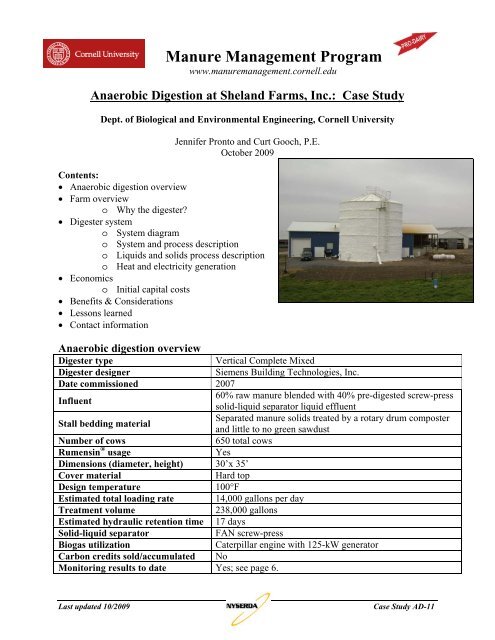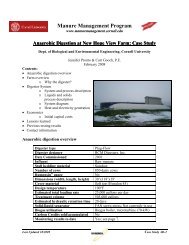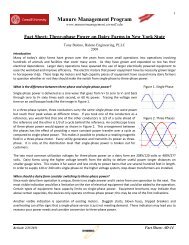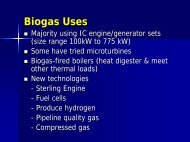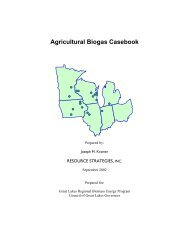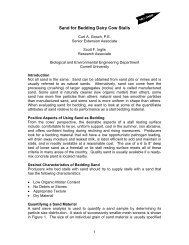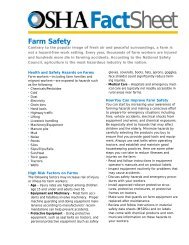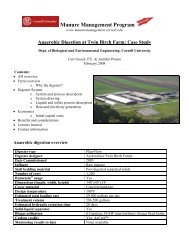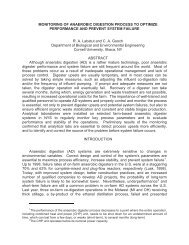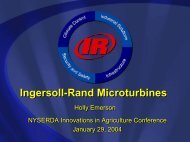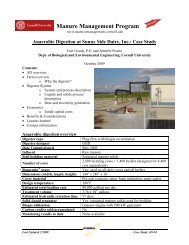Anaerobic Digester at Sheland Farms, Inc. - Manure Management
Anaerobic Digester at Sheland Farms, Inc. - Manure Management
Anaerobic Digester at Sheland Farms, Inc. - Manure Management
Create successful ePaper yourself
Turn your PDF publications into a flip-book with our unique Google optimized e-Paper software.
<strong>Manure</strong> <strong>Management</strong> Program<br />
www.manuremanagement.cornell.edu<br />
<strong>Anaerobic</strong> Digestion <strong>at</strong> <strong>Sheland</strong> <strong>Farms</strong>, <strong>Inc</strong>.: Case Study<br />
Dept. of Biological and Environmental Engineering, Cornell University<br />
Jennifer Pronto and Curt Gooch, P.E.<br />
October 2009<br />
Contents:<br />
• <strong>Anaerobic</strong> digestion overview<br />
• Farm overview<br />
o Why the digester?<br />
• <strong>Digester</strong> system<br />
o System diagram<br />
o System and process description<br />
o Liquids and solids process description<br />
o He<strong>at</strong> and electricity gener<strong>at</strong>ion<br />
• Economics<br />
o Initial capital costs<br />
• Benefits & Consider<strong>at</strong>ions<br />
• Lessons learned<br />
• Contact inform<strong>at</strong>ion<br />
<strong>Anaerobic</strong> digestion overview<br />
<strong>Digester</strong> type<br />
Vertical Complete Mixed<br />
<strong>Digester</strong> designer<br />
Siemens Building Technologies, <strong>Inc</strong>.<br />
D<strong>at</strong>e commissioned 2007<br />
Influent<br />
60% raw manure blended with 40% pre-digested screw-press<br />
solid-liquid separ<strong>at</strong>or liquid effluent<br />
Stall bedding m<strong>at</strong>erial<br />
Separ<strong>at</strong>ed manure solids tre<strong>at</strong>ed by a rotary drum composter<br />
and little to no green sawdust<br />
Number of cows<br />
650 total cows<br />
Rumensin ® usage<br />
Yes<br />
Dimensions (diameter, height) 30’x 35’<br />
Cover m<strong>at</strong>erial<br />
Hard top<br />
Design temper<strong>at</strong>ure 100°F<br />
Estim<strong>at</strong>ed total loading r<strong>at</strong>e 14,000 gallons per day<br />
Tre<strong>at</strong>ment volume<br />
238,000 gallons<br />
Estim<strong>at</strong>ed hydraulic retention time 17 days<br />
Solid-liquid separ<strong>at</strong>or<br />
FAN screw-press<br />
Biogas utiliz<strong>at</strong>ion<br />
C<strong>at</strong>erpillar engine with 125-kW gener<strong>at</strong>or<br />
Carbon credits sold/accumul<strong>at</strong>ed No<br />
Monitoring results to d<strong>at</strong>e Yes; see page 6.<br />
Last upd<strong>at</strong>ed 10/2009<br />
Case Study AD-11
Farm overview<br />
• <strong>Sheland</strong> <strong>Farms</strong> is loc<strong>at</strong>ed in the town of Ellisburg in Jefferson County, NY.<br />
• The farm is a fourth gener<strong>at</strong>ion family farm oper<strong>at</strong>ed by Donald, Douglas, and Todd<br />
Shelmidine.<br />
• The farm property has been in the family for over 100 years, and has grown significantly from<br />
50 milking cows in 1963, to 650 total dairy cows <strong>at</strong> the present time.<br />
• Cows are housed in one 6-row and one 4-row freestall barn, and are milked three times-a-day.<br />
• <strong>Digester</strong> effluent is recycled to a land base of 1,100 acres, used to raise forage crops.<br />
• Lact<strong>at</strong>ing cows and heifers are fed Rumensin ®<br />
• Copper Sulf<strong>at</strong>e is used in two footb<strong>at</strong>hs, one loc<strong>at</strong>ed in the dry cow pen and the other in the<br />
springing heifer pen.<br />
• Considerable time was spent identifying, investig<strong>at</strong>ing, and responding to multiple financial<br />
grant opportunities.<br />
• After receiving grant funds from several sources, digester construction began the fall of 2005<br />
with commissioning in the summer of 2007.<br />
• A flow diagram for the digester is shown on the following page.<br />
Why the digester?<br />
The farm sought a solution to both increasing electrical and purchased bedding costs, and<br />
determined anaerobic digestion would help meet these goals. Cow cooling electrical loads along<br />
with the electrical demands of cooling milk, are significant and thus the farm desired to reduce<br />
their annual power costs. A 125-kW engine-gener<strong>at</strong>or set is now used to gener<strong>at</strong>e electrical<br />
power from biogas produced by the digester. <strong>Manure</strong> solids to be used for freestall bedding are<br />
separ<strong>at</strong>ed out before digestion by a FAN Separ<strong>at</strong>or Bedding Recovery Unit (BRU). The BRU in<br />
essence is a rotary drum composting machine.<br />
Additional benefits of the anaerobic digester include: a proactive approach to reductions in farm<br />
rel<strong>at</strong>ed odor emissions, as well as the preserv<strong>at</strong>ion of nutrients in digested manure applied to<br />
field crops. The risk of run-off and nutrient leaching are drastically reduced when manure is<br />
properly applied to crop land in accordance with the governing Comprehensive Nutrient<br />
<strong>Management</strong> Plan (CNMP).<br />
2<br />
Last Upd<strong>at</strong>ed 10/2009<br />
Case Study AD-13
<strong>Digester</strong> System<br />
3<br />
<strong>Digester</strong> Influent:<br />
-650 cows<br />
-150 heifers P<br />
-Milking center<br />
wastew<strong>at</strong>er<br />
Influent<br />
liquid<br />
Influent pit<br />
P<br />
Solid-liquid separ<strong>at</strong>or<br />
A<br />
P<br />
FAN<br />
BRU<br />
Separ<strong>at</strong>ed<br />
solids for<br />
bedding<br />
Complete<br />
mixed<br />
digester<br />
B<br />
Biogas<br />
Gas<br />
conditioner<br />
125-kW<br />
Engine/<br />
gener<strong>at</strong>or<br />
Grid<br />
Electricity<br />
Effluent<br />
P<br />
P<br />
Roto-mix<br />
system<br />
He<strong>at</strong><br />
exchanger<br />
P<br />
He<strong>at</strong><br />
Propane<br />
boiler<br />
Electricity<br />
Legend<br />
A<br />
B<br />
Agit<strong>at</strong>or<br />
Blower<br />
Long-term<br />
digester effluent<br />
storage<br />
Radi<strong>at</strong>or<br />
(Waste he<strong>at</strong>)<br />
Flare<br />
Farm<br />
use<br />
P<br />
Pump<br />
System and process description<br />
A 238,000-gallon completely mixed anaerobic digester with a design hydraulic retention time of<br />
approxim<strong>at</strong>ely 17 days, and a design capacity of manure from 660 dairy animals, was engineered<br />
for by Siemens Building Technologies, <strong>Inc</strong>. An annual maintenance fee is paid to Siemens to<br />
keep the engine-gener<strong>at</strong>or set running smoothly. Siemens guarantees the farm 16 yards 3 /day of<br />
usable bedding from the system, and 381,240-kWh of electricity produced annually from the<br />
engine-gener<strong>at</strong>or set.<br />
Liquids and solids process description<br />
Currently, the digester processes 18,100 gallons per day of barn effluent (composed of manure<br />
from 650 cows [lact<strong>at</strong>ing and dry] and manure from 150 bred heifers) as well as pre-digested<br />
solid-liquid separ<strong>at</strong>or (SLS) liquid effluent. The r<strong>at</strong>io is about 60% barn effluent and 40% SLS<br />
liquid effluent. The farm is setup to add milking center wastew<strong>at</strong>er to the AD if it is necessary,<br />
but this is not a common addition.<br />
Freestalls consist of m<strong>at</strong>tresses bedded with processed separ<strong>at</strong>ed manure solids and some<br />
sawdust. <strong>Manure</strong> and soiled bedding are conveyed by alley scrapers to centrally loc<strong>at</strong>ed manure<br />
Last Upd<strong>at</strong>ed 10/2009<br />
Case Study AD-13
drops in each barn. A pump transfers manure from the barns, to a reception pit where it mixes<br />
with liquid off the SLS.<br />
The digester is fed unhe<strong>at</strong>ed influent every 30 minutes with a 10-Hp Vaughan pump, which runs<br />
about 5% of th<strong>at</strong> time period. A Roto-Mix ® pump/agit<strong>at</strong>or system is used to mix the digester<br />
contents, intended to prevent m<strong>at</strong>erial from settling in the conical bottom of the digester tank.<br />
This system consists of a 30-Hp Vaughan 3-phase electrical pump, loc<strong>at</strong>ed on the exterior of the<br />
digester tank. There are also two discharge nozzles loc<strong>at</strong>ed <strong>at</strong> the bottom of the digester tank and<br />
a third loc<strong>at</strong>ed <strong>at</strong> the top. Oper<strong>at</strong>ing experience has shown th<strong>at</strong> the Roto-Mix ® design works well<br />
with this particular system when oper<strong>at</strong>ed continuously for two hours on a four hour cycle.<br />
<strong>Digester</strong> effluent is transferred to the farm’s 3.5 million-gallon earthen storage by gravity.<br />
Stored m<strong>at</strong>erial (digester effluent + rainw<strong>at</strong>er) is recycled to the farm’s cropland following their<br />
CNMP using either a drag hose injection system or tankers.<br />
He<strong>at</strong> and electricity gener<strong>at</strong>ion<br />
Biogas pressure inside the digester is currently set <strong>at</strong> 10” of w<strong>at</strong>er column. Biogas flows under<br />
this positive pressure to a gas conditioner, where it is cooled and condensed to lower the dew<br />
point, removing moisture. An electric blower increases the biogas pressure to meet the engine<br />
inlet requirements. Siemens chose to install the biogas conditioner in order to reduce the enginegener<strong>at</strong>or<br />
set maintenance costs. Biogas is then sent to the gas utiliz<strong>at</strong>ion room where it is used<br />
to fire a 125-kW C<strong>at</strong>erpillar engine-gener<strong>at</strong>or set with a spark ignition system. The enginegener<strong>at</strong>or<br />
set uses on average 30 ft 3 /minute of biogas to gener<strong>at</strong>e 80 to 90-kW of power.<br />
Gener<strong>at</strong>ed power is used on-farm and excess is sold to Niagara Mohawk grid under the<br />
provisions of the New York St<strong>at</strong>e Net Metering Law (see Fact Sheet No. NM-1). Any excess<br />
biogas is autom<strong>at</strong>ically routed to and burned by a flare.<br />
Engine oil changes are performed every 700 hours of oper<strong>at</strong>ion (about once a month) with<br />
Chevron HDAX low ash gas engine oil, SAE 40 to reduce damage to the engine from the<br />
corrosive hydrogen sulfide.<br />
A 7.5-Hp Vaughan pump continuously transfers digester contents through an external he<strong>at</strong><br />
exchanger. Reclaimed he<strong>at</strong> from combustion of the engine-gener<strong>at</strong>or set is used to supply he<strong>at</strong> to<br />
the w<strong>at</strong>er-to-manure he<strong>at</strong> exchanger. The target oper<strong>at</strong>ing temper<strong>at</strong>ure for the digester is 101°F.<br />
Excess he<strong>at</strong> is dispersed to the <strong>at</strong>mosphere with a he<strong>at</strong> dump radi<strong>at</strong>or.<br />
4<br />
Economics<br />
<strong>Sheland</strong> <strong>Farms</strong> has a contract with Siemens Building Technologies, <strong>Inc</strong>. for the entire project<br />
from design and engineering to meeting oper<strong>at</strong>ional performance standards. The cost of the<br />
contract was $1,347,891 along with an annual fee of about $24,000 to maintain the enginegener<strong>at</strong>or<br />
set, switch gear and provide the performance guarantee. The estim<strong>at</strong>ed itemized<br />
capital costs for the anaerobic digestion system and equipment are shown in Table 1 below.<br />
Miscellaneous cost items include: construction supplies and m<strong>at</strong>erials, employee travel, and<br />
shipping charges for equipment and m<strong>at</strong>erials.<br />
Last Upd<strong>at</strong>ed 10/2009<br />
Case Study AD-13
5<br />
Table 1. Initial Capital Costs for <strong>Sheland</strong> <strong>Farms</strong> <strong>Anaerobic</strong> <strong>Digester</strong> System<br />
Component Cost ($)<br />
<strong>Digester</strong><br />
-Site Work<br />
-Engineering design<br />
-<strong>Digester</strong> (<strong>Inc</strong>luding cover, concrete, and he<strong>at</strong>ing pipes)<br />
-Misc.<br />
Subtotal<br />
Energy conversion<br />
-Engine-gener<strong>at</strong>or set<br />
-Electrical wiring and control systems and plumbing<br />
-Biogas utiliz<strong>at</strong>ion building<br />
Subtotal<br />
15,000<br />
200,000<br />
445,500<br />
100,000<br />
760,000<br />
146,800<br />
60,000<br />
232,917<br />
439,717<br />
TOTAL 1,199,717<br />
The farm received funding from the New York St<strong>at</strong>e Energy Research and Development<br />
Authority (NYSERDA), the United St<strong>at</strong>es Department of Agriculture (USDA) Rural<br />
Development program, and New York St<strong>at</strong>e Environmental Protection Fund totaling $1,160,000.<br />
The farm invested about $450,000 of its own money into the project including the purchase of a<br />
Fan Bedding Recovery Unit.<br />
Benefits and Consider<strong>at</strong>ions<br />
Benefits<br />
• Odor control<br />
• Potential revenue from:<br />
1) Value-added products<br />
2) Reduction of purchased energy<br />
3) Sale of excess energy<br />
4) Efficient use of biogas production<br />
5) Carbon credit sales<br />
• Nutrient conversion, allowing use by<br />
plants as a n<strong>at</strong>ural fertilizer, if effluent is<br />
spread <strong>at</strong> an appropri<strong>at</strong>e time<br />
• P<strong>at</strong>hogen reduction<br />
Consider<strong>at</strong>ions<br />
• Compar<strong>at</strong>ively high initial capital and/or<br />
high oper<strong>at</strong>ing costs<br />
• Long and tedious contracts with the local<br />
utility; may require special equipment for<br />
interconnection<br />
• Dedic<strong>at</strong>ed management of the digestion<br />
system is required<br />
• Careful <strong>at</strong>tention to equipment<br />
maintenance and safety issues due to the<br />
characteristics of raw biogas<br />
Lessons Learned<br />
The farm reported th<strong>at</strong> the following lessons were learned as a result of constructing and<br />
oper<strong>at</strong>ing their anaerobic digester.<br />
Difficulties were encountered when there was disconnection among the design team <strong>at</strong> Siemens.<br />
Different areas of the company were unaware of aspects of the project out of their scope, and the<br />
farm received very different recommend<strong>at</strong>ions and opinions from people in the same area of<br />
expertise.<br />
Last Upd<strong>at</strong>ed 10/2009<br />
Case Study AD-13
Investment was made in various pieces of equipment considered “extra” for the manure handling<br />
system (example: biogas conditioner, drag hose, SLS separ<strong>at</strong>or) in order to reduce future farm<br />
maintenance needs for the system and assist in their overall goal of recycling manure from the<br />
barn to the field, with as little effect possible on humans and the environment.<br />
The initial design was to maintain the biogas pressure within the digester <strong>at</strong> 6” of w<strong>at</strong>er column.<br />
However, it was found th<strong>at</strong> the flare would not function properly <strong>at</strong> this pressure, thus, the<br />
decision was made to increase the pressure to 10” of w<strong>at</strong>er column. Since this change has been<br />
made, excess biogas has been successfully flared, and emissions of raw biogas have been<br />
elimin<strong>at</strong>ed.<br />
Initially, oper<strong>at</strong>ing the Roto-mix system for 20 minutes of a 30 minute cycle resulted in a build<br />
up of two feet of crust on the top layer within the digester. This resulted in a significant<br />
reduction of biogas production. The farm oper<strong>at</strong>ed the Roto-mix system continuously for one<br />
week to break down the crust and biogas production successfully returned to previous levels.<br />
6<br />
Previous testing results<br />
Analysis of manure handling and digester oper<strong>at</strong>ion is based on d<strong>at</strong>a collected during a study of<br />
sulfur flow in February 2007. The farm oper<strong>at</strong>or recorded the biogas flow, temper<strong>at</strong>ure and<br />
pressure and analyzed the biogas three times each day for carbon dioxide and hydrogen sulfide.<br />
Dairy Cows: 463 (milking), 93 (dry), 71 (heifers) – 637 total animals<br />
Equivalent milking cows based on total solids entering digester: 553 +<br />
Bedding: 3.9 lb/cow-day (separ<strong>at</strong>ed solids)<br />
Total solids entering digester 9,460 lb/day<br />
Production of biogas (n=30) 39,500 ft 3 /day (wet, 60F)<br />
Temper<strong>at</strong>ure of biogas (n=90) 72°F<br />
Concentr<strong>at</strong>ion of CO 2 (n=180) 35.8 % (dry)<br />
Concentr<strong>at</strong>ion of CH 4 64.0 % (calcul<strong>at</strong>ed)<br />
Concentr<strong>at</strong>ion of H 2 S (n=180) 2,240 ppm (dry)<br />
Weight of CH 4<br />
1,002 lb/day<br />
He<strong>at</strong>ing value (low)<br />
899,000 Btu/hr<br />
546 Btu/ft 3 raw biogas<br />
+ The ASABE* equ<strong>at</strong>ions predicted th<strong>at</strong>, based on milk production, the cows would produce 18.7<br />
lbs TS per cow-day. Considering all the total solids entering the digester, the number of “cow<br />
equivalents” <strong>at</strong> <strong>Sheland</strong> <strong>Farms</strong> was calcul<strong>at</strong>ed. The production of biogas was 77.4 ft 3 per cow<br />
equivalent-day. The average for the six farms not feeding food waste was 78.8.<br />
Flow of sulfur through system (numbers in brackets are lbs sulfur/day) is shown below.<br />
TMR (72.3) <strong>Manure</strong> (38.1) Influent Effluent (37.8)<br />
pit<br />
W<strong>at</strong>er (0.71) + Bedding (3.9)<br />
(bedding) (bedding 3.9)<br />
Milk (9.6) Biogas (7.0)<br />
Last Upd<strong>at</strong>ed 10/2009<br />
Case Study AD-13
7<br />
The sulfur in the drinking w<strong>at</strong>er <strong>at</strong> <strong>Sheland</strong> <strong>Farms</strong> had a concentr<strong>at</strong>ion of 16.0 mg SO 4 / liter and<br />
accounted for 0.13 lbs S per 100 milking cows or about 1 % of the total sulfur entering the<br />
system.<br />
* ASABE Standard D384-2, 2007<br />
Who to Contact<br />
• Doug Shelmidine, <strong>Sheland</strong> <strong>Farms</strong><br />
Phone: 315-846-5640, E-mail: dshel@frontiernet.net<br />
• Stan Weeks, Stanley L. Weeks, LLC Consulting<br />
Phone: (518) 583-1914, E-mail: sweeks1997@aol.com<br />
• Curt Gooch, Dairy Housing and Waste Tre<strong>at</strong>ment Engineer, PRO-DAIRY Program, Cornell<br />
University. Phone: 607-255-2088, E-mail: cag26@cornell.edu<br />
Acknowledgements<br />
The authors would like to thank the New York St<strong>at</strong>e Energy Research and Development Authority (NYSERDA) for funding in support of this<br />
work. Any opinions, findings, conclusions or recommend<strong>at</strong>ions expressed in this public<strong>at</strong>ion are those of the authors and do not necessarily<br />
reflect the views of NYSERDA or the St<strong>at</strong>e of New York, and reflect the best professional judgment of the authors based on inform<strong>at</strong>ion<br />
available as of the public<strong>at</strong>ion d<strong>at</strong>e. Reference to any specific product, service, process, or method does not constitute an implied or<br />
expressed recommend<strong>at</strong>ion or endorsement of it. Further, Cornell University, NYSERDA and the St<strong>at</strong>e of New York make no warranties or<br />
represent<strong>at</strong>ions, expressed or implied, as to the fitness for particular purpose or merchantability of any product, appar<strong>at</strong>us, or service, or the<br />
usefulness, completeness, or accuracy of any processes, methods, or other inform<strong>at</strong>ion contained, described, disclosed, or referred to in this<br />
public<strong>at</strong>ion. Cornell University, NYSERDA and the St<strong>at</strong>e of New York make no represent<strong>at</strong>ion th<strong>at</strong> the use of any product, appar<strong>at</strong>us,<br />
process, method, or other inform<strong>at</strong>ion will not infringe priv<strong>at</strong>ely owned rights and will assume no liability for any loss, injury, or damage<br />
resulting from, or occurring in connection with, the use of inform<strong>at</strong>ion contained, described, disclosed, or referred to in this public<strong>at</strong>ion.<br />
Last Upd<strong>at</strong>ed 10/2009<br />
Case Study AD-13


